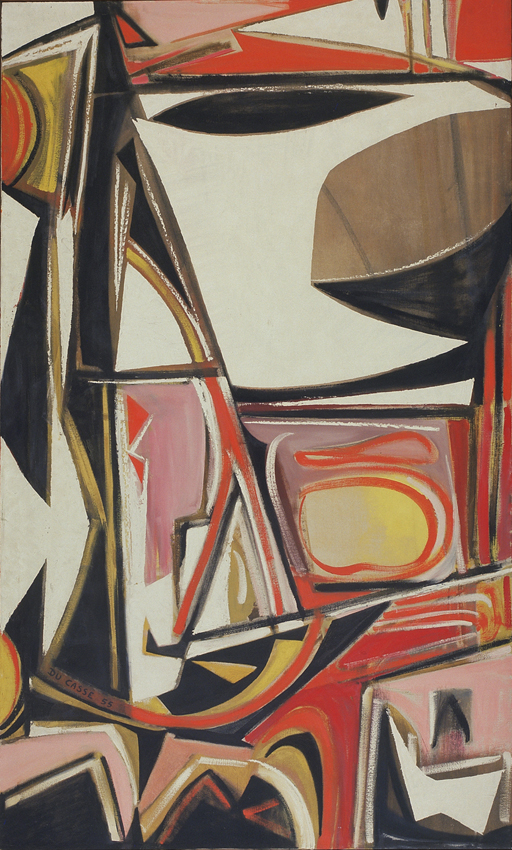Another Collection of MAC USP: Acquisition Prizes of the Bienal de São Paulo, 1951-1963
Ana Magalhães
Divisão de Pesquisa em Arte, Teoria e Crítica
(Clique para ler a versão em português)
In 1963, the Museum of Contemporary Art of the University of São Paulo (MAC USP) was founded and received he collection of the former São Paulo Museum of Modern Art (MAM). In this operation, the 1690 works gathered by the former museum, since 1948, was divided into three different donations: the Collection Francisco Matarazzo Sobrinho (428 works), the Collection Francisco Matarazzo Sobrinho & Yolanda Penteado (19 works that were only effectively donated to the University in 1973), and the so-called Collection MAMSP (1243 works). Another Collection of MAC USP is composed of a set of works selected through acquisition prizes of the Bienal de São Paulo between 1951 and 1963 that, except for the 1963 edition, were transferred into MAC USP as Collection MAMSP. Founded in 1951 inside the former MAM, the Bienal de São Paulo worked with a prize system, which aim was to foster the constant update of the collection of the museum. A lot has been written about the editions of the Bienal of those years, emphasizing its didactical character, their contribution for the making of an audience for the appreciation of modern art in Brazil, and their role in the making of a history of modern art that Brazilian artistic milieu was then becoming part of. The works exhibited in the Bienal de São Paulo, which today belong to the collection of MAC USP, has been shown quite a few times, in the last three decades, to illustrate the history of this exhibition.
But we are still to reflect upon the other history of these works, by considering them in the framework of a museum collection. Apart from the great donation that Brazilian painter Emiliano Di Cavalcanti did to former MAM in 1952, the Museum gathered 679 works in this first decade, from which almost half were Bienal prizes or exhibited and donated in the context of the Bienal editions. We now survey some elements to try to understand what was the role that the prize system of the editions of the Bienal had in the making of this collection, and what was at stake when one would talk about modern art in those years. Like the Venice Biennale, there were two kinds of prizes: the regular prizes and the acquisition prizes. The first one was given in the categories of painting, sculpture and print, separating the foreign prizes from the Brazilian ones. It was this regular prize role to celebrate the set of works of the awarded artist, but it was not for seen that such works would necessarily be donated to the former MAM, even IF in such cases, many of the awarded artists would destine at least one work to the museum's collection.
Instead, the acquisition prizes of the Bienal de São Paulo were in fact thought to be destined to the collection of the former MAM. Their constituted a system of patronage, in which the museum's direction would invite important businessmen, companies, associations, collectors to give a sum of money to buy a work or a set of works to the museum's collection. In some cases, diplomatic missions of countries taking part as national representation in the Bienal would intermediate such acquisitions or would sponsor them. Contrarily to the regular prize, the acquisition prize had thus a more objective sense of permanence.
In the selection of 115 works done here, we have privileged the acquisition prizes of the Bienal de São Paulo, in which we find names and works perhaps lesser known for us today, but which in their time were part of an international debate on the tendencies of modern art, and what it meant in that context. As we gathered the works selected by Bienal edition, we have come to realize that the acquisition prizes seemed to obey the same categories of the regular prizes: acquisition for the former MAM were made through representative works on modern painting, sculpture and print, with a few exceptions.
There is, moreover, a massive presence of works on paper. In the history of the former MAM and its continuation at MAC USP, the number of works on paper is very relevant, constituting almost two thirds of the collection. In the context of the former MAM, such works were registered as prints , even if they were drawings, gouaches, watercolors or collages, obeying a descriptive logic of media of modern art, which the big international showcases and the departments of model-museums of modern art in the world seemed to still think modern practices through traditional categories. The use of the term prints and drawings , very much in use in the period, prevailed among us, too. But such term hides the myriad of printing techniques that were on use by modern artists. In those years, there was a strong experimentation with traditional techniques of printing allied with reprographic techniques, the use of new graphic equipments on large scale, that took artists to entirely new proposals in the field of printing. Among the works here exhibited, we can count 12 different techniques of printing, being them the traditional ones (Black manner, woodcut) or more recent ones (lithograph and color linoleography, for instance).
Another big issue at stake when looking into these works is the debate on abstraction in the 1950s, in Brazil and abroad. In the Brazilian case, the Bienal de São Paulo is spoken of as a consequence of the first exhibition of the former MAM, in 1949, “From Figurativism to Abstractionism”, in which the first museum director, critic Léon Dégand, found a serious resistance to his discourse in defense of an abstract art based in the experience of concrete groups in France, in the 1930s – for which the presence of artists such as Wassily Kandinsky, Theo van Doesburg, Piet Mondrian and Uruguayan Joaquin Torres-García were key figures. Art historiography in Brazil has emphasized the emergence of Brazilian concrete groups in the 1950s and has searched to understand the Bienal de São Paulo in dialogue with this current. While thinking on the exhibition project for Another Collection of MAC USP , architect Gabriel Borba took as inspiration the composition of Theme in two dimensions, 1946, By Swiss concrete artist Richard Paul Lohse (which was shown at the I Bienal de São Paulo). This painting is a framework through which we approach the works here on show. It thus expresses the inflection of this debate, which also saw the recuperation of the art school model of the Bauhaus, through proposals of those years such as that of the Hochschüle für Gestaltung de Ulm (founded in 1955), and the presence and dissemination of these ideas in the North-American context.
However, the ongoing experiences with abstraction in the 1950s seem to open to a large horizon, with very distinct views, which involve the major battle between concrete art and informal abstraction (or tachisme), the unfolding of experimentations with surrealism, and a strong interest in the so-called “primitive” painting (made by non-professional artists).
Furthermore, in the international context North-American abstract expressionism was on the rise, and that is reflected in the case of the Bienal de São Paulo in the Jackson Pollock room in 1957 (as suggested by the bibliography on the history of the Bienal). However, and despite de hegemonic North-American cultural policy in the years of the Cold War (which certainly had had a great impact in the making of our institutions for the promotion of modern art), this is not what was being collected at the former MAM – nor was there ever the issue to overcome this gap in the modern collection of MAC USP. In this very sense, there is quite a gap in our Latin American collection. In the Bienal of the 1950s, there was another hegemonic force in action, also produced by North-American foreign affairs policy: the Pan-American Union, which organized exhibitions of Latin American artists in the editions of the Bienal de São Paulo. Based in Washington , one of its aims was to promote Latin American artists whose countries could not support an official representation at the Bienal de São Paulo. Some prizes of the Bienal come from these special exhibitions, although not effectively forming a significant group of Latin American works for the collection of the former MAM.
The narrative of modern art that was written in the context of the Bienal de São Paulo certainly implies the diplomatic relations and the political dimensions that initiatives such as that of the Pan-American Union had in the Cold War years. But when looking back at the works and artists present in that context and preserved in our collection, we must think of them as choices in the making of the history of modern art. Thus, they must be also understood as open possibilities of artistic practices. From this perspective, the collection of the former MAM was contemporaneous to its own time. We have, therefore, highlighted six works that allowed us to enter this context through transversal passages. They are: Figure with trees , a 1949 lithograph by British artist Robert Adams; The Viking , a 1955 painting by North-American Ralph Du Casse; Black independent in space, another painting from 1954 by German artist Fritz Winter; The sum of our days , 1954/55 sculpture by Brazilian artist Maria Martins; Defense of the flower , a 1957 piece of tapestry by French artist Émile Gilioli; and Mermaids II, a 1958 painting by Nicaragua artist Armando Morales. Through them, we could reveal other histories and relations that may lead us to new perspectives in the reinterpretation of our modern art collection.

